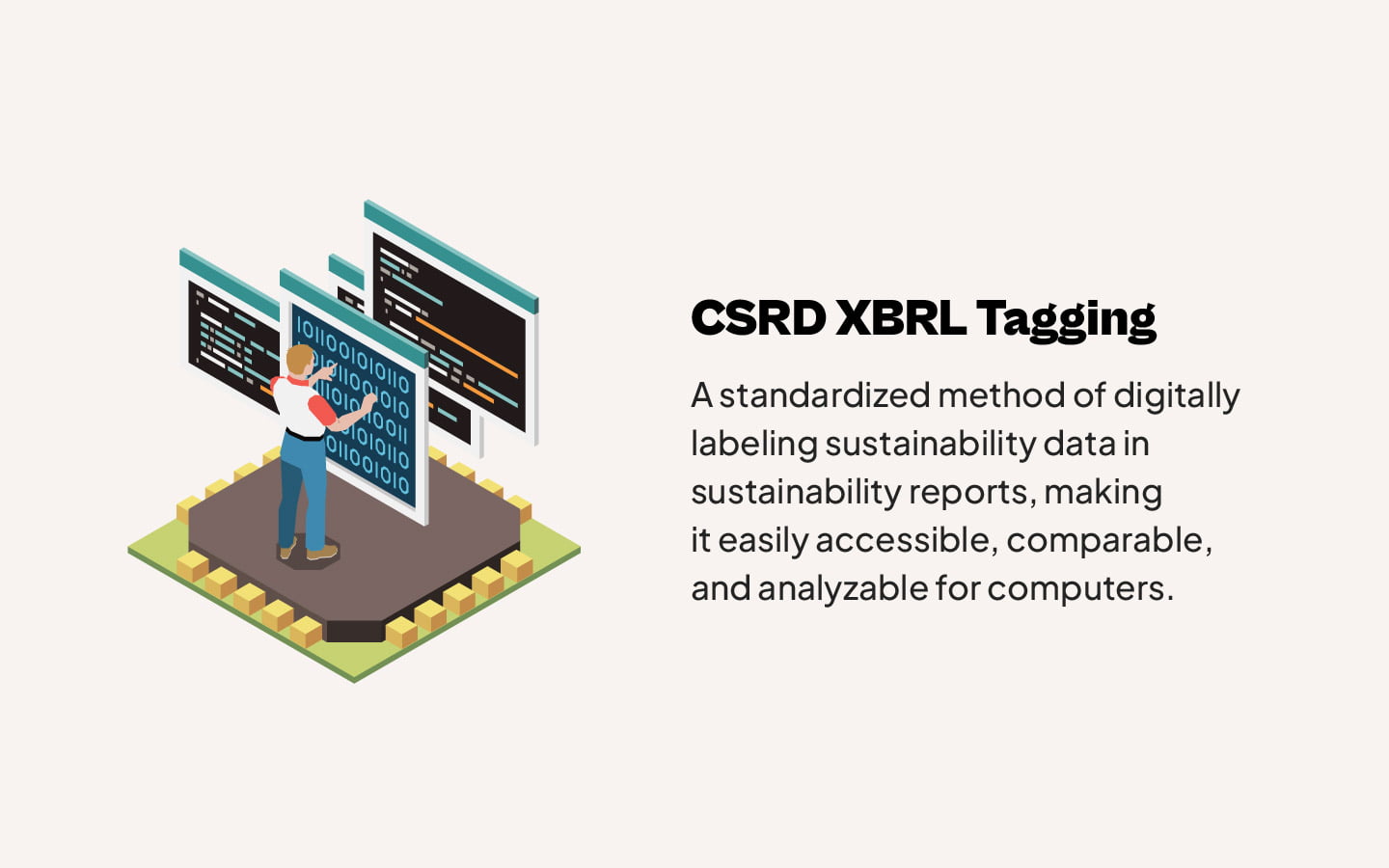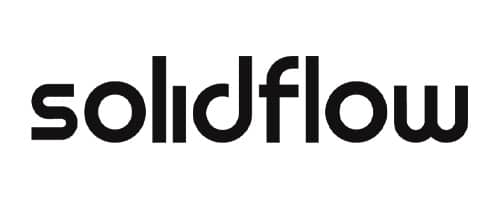What is CSRD XBRL tagging?
CSRD XBRL tagging is a system that makes sustainability reports easier for computers to understand and process. It works by adding digital “tags” to important information in the reports. These tags help computers automatically read and compare data.
Normally, a sustainability report is written for humans to read. However, by adding these tags, the report becomes machine-readable too. This makes it easier for computers to collect, analyze, and compare sustainability information across different companies.

Quick introduction to CSRD
The Corporate Sustainability Reporting Directive (CSRD) is an EU regulation that requires large companies to report on their environmental, social, and governance (ESG) activities. Its goal is to ensure businesses are transparent about their sustainability efforts. CSRD applies to all large EU companies, ensuring that they provide clear and consistent information on sustainability.
Quick introduction to XBRL
XBRL (eXtensible Business Reporting Language) is a digital format used for making financial and sustainability reports easy for computers to read and analyze. By tagging key data points, XBRL allows automated processing of reports, ensuring that the data can be quickly compared across different companies. It’s widely used in financial reporting, and now, through CSRD, it’s being applied to sustainability reporting as well.
How does CSRD XBRL tagging work?
CSRD XBRL tagging allows sustainability reports to be more easily read and processed by computers. It uses special tags to label important information in these reports, making them machine-readable while still being understandable by humans. Here’s a step-by-step look at how the process works.
1. Start with a human readable report
Companies are required to create sustainability reports each year that outline their environmental, social, and governance (ESG) performance. These reports might include information on carbon emissions, energy use, waste management, or employee diversity.
Normally, this data is presented in a format designed for people to read, but computers need more detailed instructions to make sense of the numbers. We need to simplify the process for computers by implementing digital tagging for CSRD.
Human readable reporting example:
“In 2024, we reduced our plastic waste by 40%, from 500 tons to 300 tons.”
2. Make it readable for computers with digital tagging
To make the data computer-readable, CSRD XBRL tags are added to key parts of the report. These tags work like labels that tell the computer what each piece of data means, so it can process the information correctly.
Computer readable reporting example:
<ix:nonFraction contextRef=”FY2023″ unitRef=”ton” name=”waste:PlasticWasteReduction” scale=”0″>300</ix:nonFraction> tons
This breakdown helps the computer understand key details. For example, it shows that the data is from 2023, measured in tons, and refers to a reduction in plastic waste.
- contextRef=”FY2023″: The data is from 2023.
- unitRef=”ton”: The unit of measurement is tons.
- name=”waste:PlasticWasteReduction”: This refers to the reduction in plastic waste.
3. Standardize digital tagging with CSRD Taxonomy
All the tags used follow a standard system, called the CSRD taxonomy. This ensures that companies use the same labels for the same types of data, such as emissions or waste. By using this consistent system, the reports can be easily compared between different companies.
For instance, if two companies report their CO2 emissions, both will use the same tag for “TotalCO2Emissions,” ensuring that their data is labeled consistently. This makes comparing their emissions simple, straightforward, and accurate for computers to process.
4. Save to CSRD iXBRL report
Once all the tags are added, the report is saved in a format called iXBRL (Inline XBRL). This allows the report to look like a normal document for people, but it also contains hidden tags for computers to read. The company can then publish both a human-readable document (like a PDF) and a machine-readable file (the iXBRL package).
A company might publish a sustainability report as a PDF for people to read and an iXBRL file that contains all the tagged data. This iXBRL file is ready for use by regulators and analysts.
Information on CSRD digital tagging
To start with digital tagging for CSRD, it’s essential to understand the different types of tags and their roles in digital reporting. These tags help structure complex sustainability data, making it machine-readable and easily accessible for analysis.
Different types of tags
There are several different types of tags used in digital reporting. Each type is designed to handle different kinds of information and make it understandable for a computer.
- Numerical tags: Used to label quantitative data, such as energy consumption in megawatt hours (MWh) or carbon emissions in metric tons (tCO₂e).
- Narrative tags: Applied to sections where textual information is disclosed, such as a company’s sustainability strategy or descriptions of policies.
- Boolean tags: Capture yes/no type responses. For example, whether a company has implemented specific environmental policies.
- Enumeration tags: Used for selecting predefined options from a list. For example, an enumeration tag could capture the type of renewable energy sources (e.g., wind, solar).
Dimensions and disaggregation
Often, it is necessary to provide more context to the tagged data by breaking it down further. This process is known as disaggregation and involves using dimensions to add more detail to the tagged information.
For example, while tagging your company’s carbon emissions, you might want to disaggregate the data by country or region to show how much of those emissions came from different locations. In the ESRS XBRL taxonomy, typed dimensions allow you to break down data in this way.
This means you can add extra tags to specify not only the carbon emissions but also where those emissions occurred, which department they came from, or whether they belong to CSRD scope 1, 2, or 3 emissions categories.
Validation rules for ESRS XBRL tagging
The ESRS XBRL taxonomy has three key validation rules. These rules ensure the quality and accuracy of tagged data. They help preparers, auditors, and regulators meet required standards.
The first rule is EU Legislation Datapoint Validation. It checks that disclosures required by EU laws are tagged. Companies must provide a value or state that the fact is “not material.” This ensures they comply with EU regulations and clearly show which data is excluded.
The second rule focuses on Mandatory Disclosures. Some disclosures are mandatory even if they aren’t part of the materiality assessment. These include certain general disclosures. If these are missing, the system will give a WARNING, not an error.
The third rule applies to Metrics Not Material. If numerical metrics are considered “not material,” they can be tagged as such. The system won’t raise an error if there’s no fact provided. This lets preparers pass validation without unnecessary data.
Why is XBRL for CSRD useful?
XBRL tagging for the CSRD is vital for transparency and comparability in sustainability reporting. It helps organizations deliver standardized, machine-readable data that can be analyzed automatically. Here are three reasons why XBRL tagging for CSRD useful.
1. Enhanced data accessibility and comparability
XBRL makes data machine-readable. This ensures that reports can be quickly accessed by stakeholders like regulators, investors, and the public. Instead of relying on manual extraction, software tools can instantly extract tagged data for analysis.
The tagged data can be compared across companies and sectors. This is especially useful for large-scale analyses of sustainability performance. With standard tags in place, comparisons between organizations become straightforward.
Investors can quickly analyze specific metrics like CO2 emissions, allowing for more efficient decision-making. XBRL also simplifies cross-border comparisons, as the taxonomy applies consistently across regions and languages.

2. Improved data accuracy and consistency
XBRL ensures consistent data reporting. Every relevant data point is assigned a specific tag from a standardized taxonomy. This prevents discrepancies in how data is represented across reports. It also minimizes confusion caused by variations in units or terminology.
For example, a company’s CO2 emissions will be tagged the same way across all reports. This eliminates potential misinterpretations. The use of XBRL tags reduces manual data entry errors. Validation tools also help catch any mistakes before reports are submitted. As a result, organizations can submit higher-quality, error-free reports.
3. Compliance with regulatory requirements
XBRL helps companies meet strict regulatory demands. Under the CSRD, companies must tag their sustainability data using XBRL in accordance with European standards. This ensures that their reports are compliant with EU regulations.
The tagging process also aligns with the ESRS. This makes it easier for companies to meet both financial and non-financial reporting requirements. Companies that do not comply may face penalties.
XBRL helps them avoid these risks by ensuring they meet deadlines and legal obligations. Furthermore, XBRL allows companies to comply with international standards, boosting their global competitiveness.





